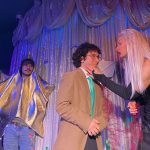Frances Marsh | Comment Editor
I have an extremely vivid memory from when I was about 14 years old. I was in the PE changing rooms at school and a girl I didnÔÇÖt really know started laughing obnoxiously.
ÔÇ£Imagine if there’s a lesbian in here watching us all get changed.ÔÇØ
She didnÔÇÖt use the word lesbian, but imagination can fill in the blanks for you. I remember her friends all bursting into laughter and the indescribable sinking feeling in my stomach. I doubt she remembers saying it now, and of course, I’m not implying that a stupid comment made as a teenager makes her homophobic, but it’s interesting to think how a throwaway comment to her is a formative memory for me. IÔÇÖd felt confused and sad about my sexuality before, but that was the first time I ever felt shameful about it.
Only two people knew I was queer at the time, my two best friends, and yet I felt like the whole room was staring at me. I hadnÔÇÖt even labelled myself yet but the anxiety was worse than any IÔÇÖd felt before and it felt like nobody else in the world could understand. How could I come out to people when my own classmates thought that queer people were perverts?
It was the next year that I discovered the show Shadowhunters, an adaptation of Cassandra ClareÔÇÖs YA series The Mortal Instruments. I was a die-hard fan from then until the show ended in 2019 and it was really my first exposure to a bisexual character on screen (or at least one that labelled themselves as such). Magnus Bane was a character who was not only proud of his sexuality, but he helped another character to come out and be proud of theirs. The show itself resonated with me in so many ways, but the fan community that came from the show was what really helped with the feelings of isolation IÔÇÖd been struggling with. I no longer felt like the only gay in the village.
In 2022, the Netflix series Heartstopper was released and whilst the webcomic it was based on already had a close-knit fanbase, it was the show that catapulted it to a huge audience. The series is clearly aimed at viewers on the younger side (the plot follows characters in years 10 and 11 of school) but it received a huge response online and people of all ages voiced their appreciation. The show follows a story of young queer love, and many older viewers expressed their delight at seeing it portrayed in such a positive and happy way. For many, it was a representation of love that they werenÔÇÖt able to have in their own youth due to homophobia and stigma.
“It provided a sense of hope that a new generation could have the happiness they were forced to hide.”
The thing with queerness is that it often brings a sense of community and belonging, but it can also bring extreme isolation and loneliness. There’s still a long way to go when it comes to representing the whole community, white gay men are often chosen to allow a piece of media to demonstrate its ÔÇÿwokenessÔÇÖ whilst remaining palatable to a wider heterosexual audience. Trans people and people of colour within the queer community are often left out of discussions of representation and this is something that cannot be left unacknowledged. This being said, it’s hard not to admire how far weÔÇÖve come and appreciate the fact that hopefully, queer kids today won’t have that experience in the PE changing room.
Image by Stock Catalog via Flickr. Image license found here. No changes were made to this image.




